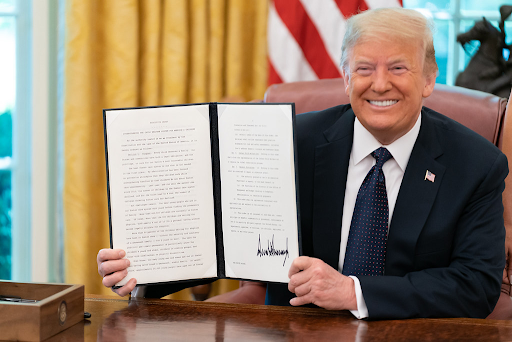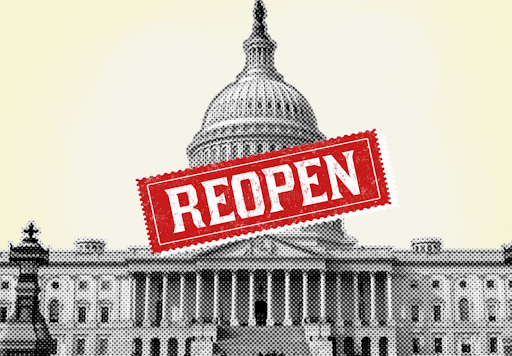
In the first week following his inauguration on Jan. 20, Trump signed a flurry of executive orders that have sparked controversy and confusion online about their consequences.
While executive orders can be consequential, they do not have the same force as legislation. Executive orders are official documents where the president creates standards for federal agencies in how they implement laws.
In addition, it may take a while to see the effects of some executive orders. A court can overturn the orders it deems unlawful, and agencies may take a long time to carry out the directives.
To clear things up, here’s a quick rundown of Trump’s most notable executive orders:
Limiting birthright citizenship
What it says: Trump signed an order entitled “Protecting the Meaning and Value of American Citizenship,“ which denies citizenship to U.S.-born children whose parents are not citizens or lawful permanent residents. This means that if a child is born to parents visiting the U.S. with a visa (whether a student, work, or tourist visa) or who are seeking asylum in the U.S., the child will not be eligible for citizenship.
The first section of the 14th Amendment states that “all persons born or naturalized in the United States, and subject to the jurisdiction thereof” are U.S. citizens. Trump interprets “subject to the jurisdiction thereof” to exclude children born in the U.S. to nonpermanent citizens.
What it can do: Trump is directing federal officials, including the Secretary of State, the Attorney General, the Secretary of Homeland Security, and the Commissioner of Social Security, to review the regulations and policies in their respective agencies to exclude these children from receiving citizenship papers.
This order has received a lot of attention, but it has not revoked birthright citizenship, and it is highly unlikely that it ever will.
Courts have blocked its implementation, in some cases calling the order “blatantly unconstitutional.” They argue the 14th Amendment clearly asserts that citizenship is an unalienable right assigned at birth, not a privilege or a “gift” as the executive order describes.
Gender definition policy
What it says: The order declares that there are only “two sexes”: the sex with the “large reproductive cell at conception” is female, and the sex with the “small reproductive cell at conception” is male. (This definition of sex has brought much pushback and confusion since biologists say egg cells develop many weeks after conception, and sperm cells are produced at puberty, not at conception.)
In the name of “defending women from gender ideology extremism and restoring biological truth to the federal government,” the order mandates that the federal branch “assert biological distinctions.” This means that in the federal government’s everyday operations, they are ordered to acknowledge and refer to individuals by their “sex” rather than their “gender identity.”
The Secretaries of State and Homeland Security are ordered to oversee changes to ensure that government-issued documents (including passports, visas, and Global Entry cards) only offer male or female options.
What it can do: The order has already impacted passport policy. Secretary of State Marco Rubio halted the processing of gender-changed passports, leaving transgender and intersex Americans with mixed identification papers and uncertainty.
In a practical sense, an executive order is not legislation, so only the federal government needs to implement it—meaning that state laws on bathroom use, gender-affirming care, and sports participation are not affected, and private businesses can maintain gender-neutral language and identification.
Omar Gonzalez-Pagan, a Lambda Legal lawyer, told AP News that the order does not change current law but instead sends “a clear signal and road map of where this administration’s policies lie when it comes to transgender people.”
Department of Government Efficiency (DOGE)
What it says: The text of the executive order establishes the Department of Government Efficiency (DOGE) by renaming the United States Digital Service (USDS), an agency established under President Obama to improve inefficient government technology.
Even though the federal department it replaces was directed toward refining government software and technology, the main goal for DOGE is to cut down general federal government spending.
Trump has publicly appointed Elon Musk as Head of Agency, but White House papers filed him as Senior Advisor to the President.
The executive order aims to “increase the efficiency of selecting and recruiting government employees” through a process that “prioritizes candidates” committed to the “ideals of our American republic without consideration of race, sex, or religion.”
However, some aspects of DOGE remain unclear. The inner workings of the “temporary agency” are not very transparent, to the point that a judge recently ordered an “urgent release” of DOGE records due to its “unprecedented power” and “unusual secrecy.”
What it can do: So far, besides terminating contracts, leases, and grants, DOGE has terminated Diversity Equality and Inclusion (DEI) programs, made cuts to the Department of Education, effectively shut down USAID, and has taken over the U.S. Institute of Peace (USIP).
On Mar. 18, a U.S. District Court judge ruled that the USAID shutdown was unconstitutional and ordered agency functions to be partially restored.
The legal battle between the Trump administration and the USIP continues to escalate over whether Trump can dismantle an organization established and funded by Congress.
“DOGE has claimed more than $1 billion per day in spending cuts, though it hasn’t provided a detailed breakdown,” FoxBusiness reports. “It’s unclear how it is calculating the amount of savings it is claiming, or the overall figure.”
Coupled with other executive orders freezing the hiring process for federal workers, the “agency” has a broad reach and threatens to overhaul the federal bureaucracy. Many journalists, legislators, and judges are questioning the legality of DOGE.
Only Congress has the power to create federal departments for the bureaucracy, which is why Trump renamed USDS and has called DOGE a “temporary agency” within that department.
In this constitutional grey area, journalists and legislators are primarily concerned with identifying “the legal authority that governs DOGE’s operations” and ensuring its accordance with “federal transparency requirements.” Until these lawsuits against DOGE are decided, DOGE’s operations will be contested in court.
Withdrawing from the WHO
What it says: In two different orders, Trump moved to withdraw the U.S. from the World Health Organization. The order blames the WHO for “mishandling” the COVID-19 pandemic and failing “to adopt urgently needed reforms.”
It also asserts that the WHO “demand[s] unfairly onerous payments from the United States.” Trump has publicly said: “World Health ripped us off…That’s not going to happen anymore.”
He ordered federal agencies to submit a report on their actions within 30 days.
What it can do: It will take a year for the withdrawal from the World Health Organization to become official.
Critics of this order believe that the U.S. will face negative consequences for this withdrawal. The WHO monitors global health threats and coordinates appropriate responses to emerging health crises. By withdrawing from the organization, the U.S. would lose first-hand access to critical data on outbreaks and its prominent role in discussions that set health standards and decide disease responses.





































